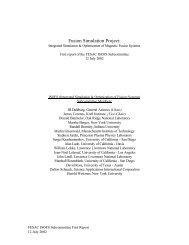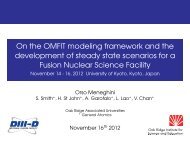introduction to gyrokinetic and fluid simulations of ... - Our Home Page
introduction to gyrokinetic and fluid simulations of ... - Our Home Page
introduction to gyrokinetic and fluid simulations of ... - Our Home Page
You also want an ePaper? Increase the reach of your titles
YUMPU automatically turns print PDFs into web optimized ePapers that Google loves.
Equivalent particle approach<br />
Discrete particle density representation (combined with smoothing <strong>and</strong><br />
“particle-in-cell” techniques):<br />
dxi<br />
dt<br />
= vi<br />
Fs = <br />
i=1,N<br />
wi(t)δ(x − xi(t)δ(v − vi(t)<br />
dvi<br />
dt<br />
= qi<br />
mi<br />
⎛<br />
⎜<br />
⎝ E(xi, t) + vi × B(xi, t)<br />
c<br />
plus Monte Carlo treatment <strong>of</strong> collisions, sources <strong>and</strong> sinks.<br />
Both “continuum” F <strong>and</strong> particle descriptions are equivalent (in the limit <strong>of</strong><br />
a large number <strong>of</strong> particles, typical fusion particle density ∼ 10 14 /cm 3 ) <strong>and</strong><br />
are“Exact”, but both include an excessive range <strong>of</strong> time <strong>and</strong> space scales.<br />
Most plasma phenomena <strong>of</strong> interest are slow compared <strong>to</strong> the electron <strong>and</strong> ion<br />
gyr<strong>of</strong>requencies (∼ 10 11 Hz <strong>and</strong> ∼ 10 8 Hz).<br />
⎞<br />
⎟<br />
⎠





